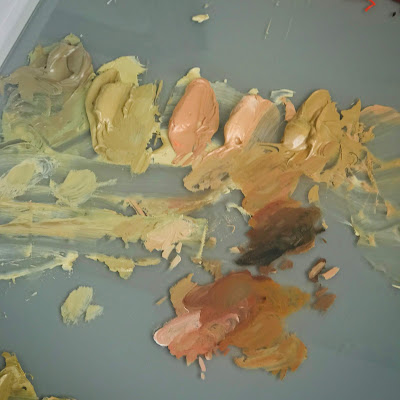For quite awhile I've been kicking around the idea of a series of paintings having to do with our solar system in relation to earth. Although I have a lot of ideas, I wanted to start off with a really small series that included either animals or insects each relating to the Earth, the Sun, and the Moon. After a lot of sketching and thinking, I landed on a cicada, a bee, and a moth. I chose these insects because cicadas hibernate in the earth for many years, bees are active in sunlight hours, and moths are nocturnal.
I also wanted these to be illustrations rather than scientific studies of any specific species. It was really a challenge...I messed around with embellishing each insect with symbols and landed on a few, but then altered those in the final paintings.
All of these are drawn on heavy weight duralar vellum, a surface I really like for graphite studies. The warm tone you see underneath is a table top.
I also wanted these to be illustrations rather than scientific studies of any specific species. It was really a challenge...I messed around with embellishing each insect with symbols and landed on a few, but then altered those in the final paintings.
All of these are drawn on heavy weight duralar vellum, a surface I really like for graphite studies. The warm tone you see underneath is a table top.
I gilded each 6x6 panel in three metal leafs, copper to represent the Earth, Gold to represent the Sun, and Silver to represent the moon. (I ended up double gilding the copper panel to remove the seams you see in the photo)
I should note here that these panels are all oil gilded rather than water gilded. Oil gilding involves applying oil size and allowing it to dry for a specific time before adhering the metal leaf. Water gilding is a different process that yields great results, too, and is often used for making very slick and shiny surfaces, which I wasn't necessarily interested in for these little pieces. Also, I gilded the panels straight onto a white gessoed surface instead of applying a base color (typically called a "bole").
I scanned my drawings, made line drawings in photoshop, then printed out the designs to the specific size I needed, and then transferred them to the gilded panels. This time I used white graphite transfer paper so that the line work could show up against the metal leaf.
I painted a closed grisaille underpainting first so that paint adhered to the surface before adding color. I'm glad I did because the metal leaf was slick to paint on, requiring some layers of paint as a base before adding color.
One really cool thing about the metal surface is that it reflects light even in the middle of the night with all of the lights turned off. I tried to capture this a bit. (Sorry for the shaky cam!)
After the grisaille under paintings were finished, I moved to detail color work. I found with each one that balancing the transparency of the wings for "Earth" and "Sun" against the metal leaf was quite difficult. I probably spent more time working on the wings than any other aspect of each painting. It was also difficult to gauge the color structure while painting because the shimmery metal leaf would change during the day and change the nature of the color. In some cases I repainted the color layer twice in order to adjust.
Varnishing these paintings took a few tries, as well. I ended up reapplying the varnish and stripping it a few times. I think a matte varnish works really well with these. The metal leaf still looks shimmery and the painted surfaces end up having a nice matted quality that contrasts well.
The finished paintings, "Earth", "Sun", "Moon".
I plan to continue this series with larger pieces later this year, which I am very excited about... For the mean time, I am in the midst of two more gothic themed paintings, one of which you can follow along with on instagram and twitter:
Thank you for reading!





























